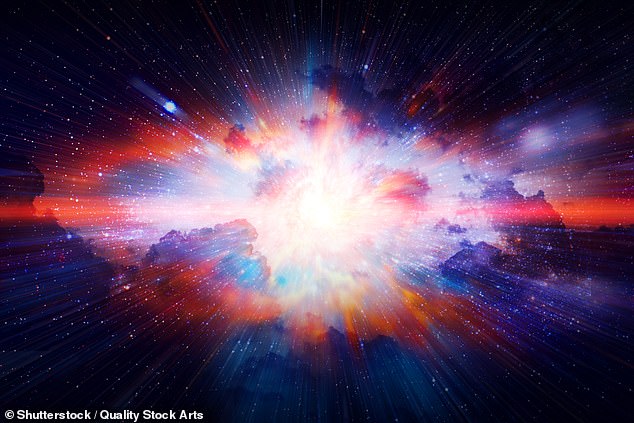A controversial new theory about how the universe began rejects the widely-held belief that it started with a giant cosmic eruption known as the Big Bang.
One scientist suggests that the cosmos grew through numerous rapid-fire bursts rather than a single, massive explosion.
This alternative explanation, published by professor Richard Lieu of The University of Alabama in Huntsville, challenges one of the most foundational, long-standing theories in all of cosmology.
Lieu argues that each of these bursts, known as ‘temporal singularities,’ blasted new matter and energy out into space, which become planets, stars, galaxies, and everything in-between.
The Big Bang theory, by comparison, proposes that the universe began as an infinitely small, hot point of densely packed matter and energy.
That point then exploded into a flood of matter and energy that rapidly expanding, and is still expanding today, though the cause of the initial explosion remains unknown.
This has been the prevailing explanation for the origin of the universe since the 1960s. But despite its prominence, this theory is challenged by new investigations into concepts like dark matter and dark energy, which invisible particles scientists believe fill the universe.
The Big Bang model cannot work without the presence of these elusive particles. But so far, scientists have not been able to prove that they exist.
Lieu believes his theory overcomes this limitation, offering a new framework for the birth of the universe that does not require dark matter or dark energy.

A new theory about how the universe began rejects the widely-held belief that it started with the Big Bang (STOCK)
The temporal singularities proposed in his new paper, published in the journal Classical and Quantum Gravity, aren’t confined to a single explosive beginning (like the Big Bang).
Rather, they have continued sending bursts of energy and matter out into the cosmos throughout history.
Their collective impact has pushed the universe to expand and flooded it with the materials that make up all the cosmic structures we see today.
These random bursts happen rarely and quickly, dissipating before they can be detected by current technologies like telescopes, according to Lieu.
This theory could explain the structure of the universe we see today, and why it’s expanding rapidly, without the need for dark matter or dark energy.
According to the Big Bang theory, dark matter is the invisible scaffolding that holds all the structures of the cosmos in place, while dark energy is the undetectable force that is pushing the universe to expand faster and faster.
Unless we assume that these mysterious substances exist, this theory begins to fall apart.
Without dark matter, the early universe wouldn’t have had enough gravitational pull for galaxies and galaxy clusters to form so soon after the Big Bang, as modern observations suggest they did.

The Big Bang theory proposes that the universe began as an infinitely small, hot point of densely packed matter and energy that then exploded, rapidly expanding
Dark energy is needed to explain why observations show the universe’s expansion rate is increasing, with scientists theorizing that it acts as a repulsive force pushing the cosmos to stretch out faster and faster.
To sum up, assuming these pulling and pushing forces exist is essential to making the Big Bang theory match what we actually see in the universe.
Lieu has attempted to rework the model of the universe so that it aligns with the known laws of physics and the observable universe without relying on forces we have not been able to directly prove.
But while his temporal singularities offer an intriguing alternative, this theory comes with its own limitations.
For one, these fleeting bursts are, by definition, unobservable. Much like dark matter and dark energy, there’s no direct evidence to support their existence.
What’s more, there is far more indirect evidence to support dark matter and dark energy than temporal singularities.
Lieu’s theory also fails to explain what causes temporal singularities, and it still needs to be validated with experimental evidence.
To accomplish the latter, he plans to use ground-based telescopes to look for ‘jumps’ in redshift, a phenomenon where light from a distant object shifts toward the red end of the visible light spectrum as it moves further away.
Astronomers use redshift to calculate the expansion rate of the universe, and ‘jumps’ in redshift could support Lieu’s claim that brief bursts of energy are driving the universe’s expansion.






